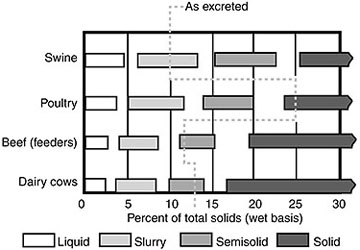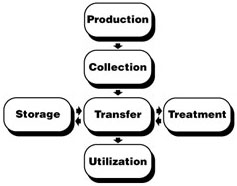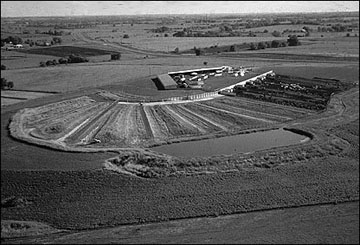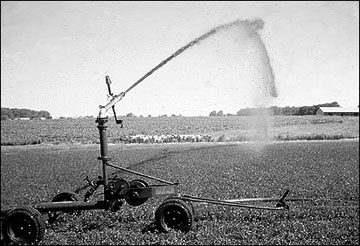Most beef cattle operations in Missouri are relatively small pasture-based operations and are not regulated (Figure 1). Permits or letters of approval are not required for animal feeding operations that are less than 300 animal units (AU) in size or are bare feeding areas within a pasture, or barn lot feeding areas where the cattle have free access to pasture.
 Figure 1
Figure 1
The majority of beef cattle in Missouri are managed in pasture systems that do not require a permit under the state's Clean Water Law.
However, the Missouri Clean Water Law, in simple terms, states that "it is a violation to allow the discharge of a pollutant or contaminant to waters of the state" without a discharge permit. The Clean Water Law applies to all production enterprises regardless of size. Therefore, beef producers are urged to maintain vegetation on pastures, especially next to streams and bodies of water, and to follow recommended management practices when collecting, storing, transporting and applying manure to fields.
A concentrated animal feeding operation with 1,000 animal units or more is required by state law to obtain either a general or a site-specific construction and operating permit from the Missouri Department of Natural Resources if it meets each of the following three criteria:
- Animals are confined for a total of 45 days or more in any 12-month period
- A ground cover of vegetation is not sustained over at least 50 percent of the animal confinement area
- One of the following size criteria is met:
- Class IA, IB or IC operation (greater than 1,000 AU)
- Class II operation (between 300 and 999 AU) that discharges through a man-made conveyance into waters of the state or where pollutants are discharged directly into waters of the state which originate outside of and pass over, across or through the facility.
One beef feeder or beef slaughter animal equals one AU.
Missouri state law establishes classes of concentrated animal feeding operations (CAFOs) based on size:
| Class | Size |
|---|---|
| Class IA | 7,000 animal units |
| Class IB | 3,000 to 6,999 animal units |
| Class IC | 1,000 to 2,999 animal units |
| Class II | 300 to 999 animal units |
For more details, see Guide to Animal Feeding Operations, May 1999, Missouri Department of Natural Resources — Water Pollution Control Program, P.O. Box 176, Jefferson City, Mo. 65102.
Before constructing any CAFO or manure handling system, have all plans approved as necessary by local health and regulatory authorities. Contact the Technical Assistance Program (TAP) at the Missouri Department of Natural Resources at 800-361-4TAP for information regarding permits and your local office of the Natural Resources Conservation Service or MU Extension for assistance in planning manure management systems.
Overview
Missouri beef manure management, usually for feedlots rather than for pasture systems, can be classified into four systems: solid, semisolid, slurry and lagoon (liquid), depending on the solids content, which determines the equipment used for collection, transportation and distribution of the manure onto the fields. Differences between these systems depend on the amount of bedding and water dilution used by a specific operation. A key to efficient manure management is to keep clean water clean, to minimize the quantity of water added to the manure, which must be hauled or pumped at some time. That is, keep runoff from "clean fields" and roofs diverted from areas with manure (e.g., lots and lagoons).
Solid, semisolid, slurry, lagoon and pasture systems, or any combination, can be developed to meet Missouri Clean Water Law requirements. Any livestock waste management system, regardless of size, must be designed and operated in a manner that will not pollute surface or ground water. See Figure 2 for relative handling characteristics of different types of manure. A typical manure management system includes the following functions: production, collection, transfer, storage, treatment and utilization. See Figure 3. All the functions may not apply to a given system. A lagoon system combines treatment and storage functions.
 Figure 2
Figure 2
Relative handling characteristics of different types of manure.
 Figure 3
Figure 3
Manure management system functions.
Many beef operations use more than one system. Frequently, most of the manure is spread by the animals while on pasture, thus eliminating the cost of collecting, transporting and distributing the manure onto fields. Manure distribution and water quality can be enhanced by low-cost measures such as disbursing salt blocks and moving hay feeders frequently. Higher-cost measures include disbursing water supplies to draw cattle away from stream-side areas and fencing off buffer strips along streams. A recent trend in beef production is intensively managed grazing, which optimizes forage production and distributes the manure by rotating stock at regular intervals among small, fenced paddocks. This method is well suited for cow/calf and backgrounding operations.
Manure from loafing sheds and calving pens may contain considerable bedding and can be handled as a solid. Feedlots can be scraped to remove solids and semisolids, which are spread onto fields, pushed into a manure pit or tank where dilution allows the manure to be handled as a slurry, or stored for later land application as a solid after a portion of the liquids have drained out. The drained liquids, and feedlot runoff from precipitation, may be stored in a lagoon or holding pond and later pumped to fields for application by irrigation or direct injection, or hauled to the fields by a tank wagon or truck and broadcast or injected. Few beef cattle are fed under roof, where the manure is either stored in a pit as a slurry or flushed to a lagoon Most beef feedlots are open dirt lots, typically with fenceline bunks and earth mounds to provide a relatively dry area for the cattle to lie down. Lot runoff can be routed through a settling basin to remove larger solids, and the liquid can be stored in a holding pond for later land application. The portion of solids retained in the settling basin may be spread as a solid or a semisolid, or agitated with sufficient water to be handled as a slurry.
Solid systems were used exclusively in the past, usually with considerable amounts of bedding used in barns to absorb the liquids. Solids may be scraped periodically from open lots during dry weather and hauled to a field, or scraped and stored for later hauling and land application. The consistency of solid manure will vary with the amount of bedding incorporated into the manure and the amount of drying that takes place before hauling.
Semisolid handling systems, using minimal amounts of bedding and with most of the liquid evaporated or routed to a soil-plant filter, minimize the volume of manure and may reduce the cost of transporting the manure to distant fields for application. Side-discharge spreaders are commonly used for transporting and spreading semisolid manure.
Slurry systems for beef manure are rare and usually use slatted floors over pits and under roof for finishing cattle for market. Slurry systems maximize recovery of plant nutrients from manure and are often used where geological conditions are unsuitable for a lagoon system. These systems increase the mass of manure to be handled (compared with handling solids) because of the higher water content, but allow the manure to be handled as a fluid. Agitation is required during the emptying process to remove settled solids when the manure is collected and stored in pits or tanks. Normally, bedding is not used with slurry systems. Slurry can be hauled in tankers or pumped through pipes to irrigators or to tractor-drawn, hose-fed injectors.
Lagoon systems are applicable where flushing is desired or where significant amounts of lot runoff must be contained (Figure 4). Large holding ponds are also used to store lot runoff until the effluent can be applied to the land. Flushing is one method of manure collection and transportation for livestock confinement systems. Flushing eliminates the labor required for scraping and moving manure to storage. Lagoons complement flushing systems because they provide storage at relatively low cost and usually do not cause unacceptable odor problems if judiciously located. Lagoons can also provide a source of flush water. Fresh water flushing should be used only if the system is designed for fresh water flushing.
 Figure 4
Figure 4
Lot runoff from this beef feeding facility is routed to a lagoon for later land application by irrigation.
Lagoons permit the use of pumps, pipes and irrigation systems (or tractor-drawn, hose-fed injectors) to minimize the labor involved in transporting and applying the manure to the land (soil-plant filter) to be used by crops. Long-term storage and treatment in a lagoon reduces the land area required to assimilate the nitrogen due to reductions of up to 80 percent in the nitrogen contained in the lagoon effluent. The nitrogen reduction can be an advantage if land is limiting or a disadvantage if crops are available to make use of all the nitrogen from a livestock operation. Using this strategy, an assessment of long-term phosphorus impact is needed.
Manure management
To minimize the potential for both air and water pollution and to maximize nutrient recovery, manure should be incorporated into the soil as soon as possible after application. To prevent applying an excess of plant nutrients (N, P and K), long-term records should be kept on the amount applied to each field. An analysis should be made to determine the nutrient content of the manure, and an accurate measurement of the amount of manure applied is also necessary. The amount of land required for manure application is usually based on the number of pounds of nitrogen and phosphorus per acre removed annually by crop production (pasture, hay, grain, etc.). When determining ideal manure nutrient requirements in the field, consideration should be given to data from manure nutrient testing, soil testing, crop yield and plant tissue analysis.
Solid/semisolid manure systems
Solid manure characteristics
Manure with 75 to 80 percent moisture content can usually be handled as a solid. Manure at this moisture content has the consistency of putty. Beef manure, as excreted, contains about 88 percent water. To be handled as a solid, beef manure must have some of the liquid drained off or bedding added. Addition of 12 to 20 pounds of dry wheat straw per 100 pounds of "fresh manure" (equivalent to about 7 to 12 pounds of straw per day per 1,000-pound feeder animal) is needed to permit handling beef manure as a solid. Manure from bedded housing usually has to be handled as a solid. See Figure 2.
Semisolid manure characteristics
Beef feeder manure, as excreted, contains about 88 percent water (12 percent solids) and is at the wetter end of the semisolid range (Figure 2). Freshly excreted manure can be pumped to storage or be made to flow by gravity through large-diameter pipes (20 to 36 inches).
Scraping systems
Solid and semisolid manure can be scraped into a holding area where liquids are allowed to drain off. Scraping can be done mechanically by alley or gutter scrapers pulled by cables or chains. In Missouri, small tractors with front- or rear-mounted blades, and skid-steer loaders are commonly used to scrape manure. Tractor-type scrapers function better in cold weather and tend to be more dependable than mechanical gutter scrapers.
Loaders
Front-end tractor loaders can remove manure from large areas with high clearances although traction and stability can be a problem. Wide front axles can improve stability and weights on the rear wheels or front-wheel-assist can improve traction. Skid-steer loaders can work in cramped quarters and, in general, lessen time and labor expended.
Manure storage
Storage is required with most solid handling systems because of weather or a limited amount of land area available for application. A 90-day minimum storage capacity is recommended. The storage area should have all-weather access with outside surface runoff water diverted away from the storage area. Any draining liquid should be directed to a soil-plant filter, lagoon or holding pond. A roof can eliminate the need for collecting and storing runoff from the storage area.
Manure spreaders
Most tractor-pulled or truck-mounted box-type manure spreaders for solid manure have moving aprons, moving front end-gates, or conveyors to move the load rearward to beaters. Water-tight box spreaders may be suitable for semisolid manure and for road transport. Flail-type spreaders have chains attached to a shaft that revolves at high speed to flail the manure out of an open-top tank. Flail-type spreaders are suited for both semisolid and solid manure.
Slurry waste systems
Manure with 90 to 96 percent moisture content can usually be handled as a fluid but may require special pumps. Waste with 96 to 98 percent water content can be handled with ordinary pumps and flushing equipment if excessive straw or fibrous material is not present. For conventional pumping, 2 gallons of water must be added to dilute a gallon of fresh beef manure (at 88 percent moisture content) to 96 percent moisture content. This triples the volume of manure to be stored and transported.
Flushing is not well suited to a slurry waste management system. Slurry systems are designed to minimize dilution, thus making it possible to use tank wagons for transportation and application. Hauling extra water with a slurry system is not practical.
For example, assume 100 head of 1,000-pound feeders produce 750 gallons of undiluted waste per day. Hauling their yearly waste output will require 91 trips to the field with a 3,000-gallon tank wagon. If their manure is diluted to 4 percent solids, approximately 270 trips per year will be required.
Scrape to storage
Scraping into below-ground storage areas can reduce equipment investment and maintenance costs. Any system that involves uncovered concrete lots, alleys or exercise areas increases the amount of runoff water that is hauled. Above-ground tanks require scraping into a collection pit and then pumping.
Slurry waste storage
Slurry can be stored in earthen pits (basins), in below-ground and above-ground concrete tanks, and in lined and unlined metal tanks. A 180-day minimum storage capacity is recommended. In some locations, soil type can prohibit the use of earthen basins or require the use of a membrane-type liner. In these locations, concrete or steel manure storage tanks may be used. Consider using a cover to prevent additional rainfall from entering the structure.
In-ground tanks must be designed to resist lateral forces from the soil when the tank is empty. Outside foundation drainage may be necessary to prevent the tank from floating when it is empty and the soil is saturated. Depending on the location of buildings and lots, it may be possible to gravity drain and scrape waste into the storage structure. Most above-ground tanks have the added expense of a dedicated pump to transfer waste in and out of the facility.
Earth pits (basins)
Earth basins are usually partially below the original grade and partially above. The above-ground berms divert surface runoff water from the basin. Check with the Natural Resources Conservation Service and the Missouri Division of Geology and Land Survey, 573-368-2100, for suitable sites, soil suitability and construction details to avoid seepage polluting surface or ground water. Earthen basins must be constructed with a clay seal (bottom and sides) to prevent leakage. In some cases, an artificial or concrete liner may be required. If the site is:
- In an area with karst terrain
- Rated as having a severe collapse potential, the Missouri DNR will not approve an earthen manure storage structure.
In these cases, an alternate site must be selected, or a concrete or steel tank must be used for storage.
Pumps
Pumps are frequently used to move waste into tanks and to move waste from tanks into tank wagons. High-capacity pumps (1,000 to 3,000 gallons per minute) are used to remove cattle manure from storage, with extra capacity for agitation to mix solids and liquids. An alternative is a propeller-type agitator used in conjunction with a pump. If long, fibrous materials are present, a chopper pump is usually required. Pumps may also be used to pump slurry to a sprinkler irrigation system or to a tractor-drawn, hose-fed injector. Land application by injection reduces odor and the risk of manure loss by volatilization and surface runoff.
Tank wagons
Tractor-drawn tank wagons have capacities from 1,000 to 10,000 gallons. For long hauls or large operations, a tank truck may be more economical. Tank wagons can either spread the liquid on the soil or be equipped with knives to inject the manure into the soil. Injection reduces odors and nitrogen loss but requires considerable power to pull the tank wagon and injectors at a reasonable speed.
Hose-fed, tractor-mounted injectors are frequently used to apply slurry or lagoon effluent to the land within a reasonable distance from the storage. For pumping long distances to the soil-plant filter, buried PVC pipe or portable aluminum pipe is more economical than an all-hose system.
Injection cannot be done when the soil is frozen or if it is too rocky. Likewise, spreading manure on frozen soil could pollute surface water if it rains or snowfalls melt while the ground is still frozen. Therefore, the Missouri Department of Natural Resources prohibits spreading manure on frozen ground.
Slurry waste systems result in more nutrients, especially nitrogen, being delivered to the land for crop use than are delivered with a lagoon system. Depending on the method of land application and degree of incorporation, nitrogen use may be at least twice as efficient. Thus, less commercial fertilizer has to be purchased.
Lagoon waste systems
Characteristics
Lagoon systems handle highly diluted waste (96 percent or more water) that can be pumped through irrigation systems. Most lagoon effluent is more than 99 percent water, so it has the consistency of water. The anaerobic breakdown of manure in a lagoon usually results in acceptable odor levels when the effluent is applied by an irrigation system.
Up to 80 percent of the input nitrogen can be lost in a lagoon, but this can be an advantage if limited land is available for manure application. For large operations, lagoons may provide a lower-cost alternative than a slurry system on a per-animal basis. Consideration should be given to separating fibrous material (if bedding is used) from the manure flow going to the lagoon. Experience has shown that excessive amounts of this material can build up as a surface crust and increase the rate of sludge accumulation in the lagoon, thus decreasing its long-term effectiveness as a waste storage and treatment facility. Agitation can facilitate sludge removal and a surface crust can decrease the odor from a lagoon.
Lagoons are usually designed for a 365-day storage capacity. Also note that lagoons are not allowed by Missouri DNR at sites with karst terrain rated as having a severe collapse potential.
Lagoons are usually formed by excavation and above-ground berms. The berms divert surface runoff water from the lagoon, but a diversion channel may be required. For an Missouri DNR-approved lagoon, a clay seal (compacted, usually by a sheepsfoot roller, to meet permeability specifications) must be applied to the bottom and sides. Also, lagoons must be filled with fresh water to the minimum operating level, and the berms must be seeded and mulched before operation.
Pumps
Conventional irrigation pumps may be adequate for pumping lagoons if the intake is floated 1 to 2 feet below the surface. The floating intake prevents interference from surface debris and reduces the handling of sludge. Centrifugal power-takeoff irrigation pumps are a practical alternative for irrigating from lagoons. If the lagoon contains long, fibrous materials, a chopper may be required ahead of the pump. To help maintain lagoon capacity and reduce operator frustrations, combine lagoon agitation to allow pumping of the sludge and floating materials with the use of a hydraulically driven, submersible chopper pump to reduce inlet clogging and eliminate the need to prime the main pump.
Irrigation systems for land application of manure
A complete waste management system includes a way of spreading manure in a pollution-free manner. It is important that all irrigation systems be monitored while effluent is being applied so that no runoff occurs from the application site.
Surface irrigation
Uniform application is essential to proper fertilizer use. Design for cutback or use a "clean water" presoak to get even application. Gated pipe can provide a low-cost distribution system for pumping small lagoons or holding ponds, especially where uniform application is not critical, but care must be taken to prevent overapplication of nitrogen. Small systems can use a "homemade" gated pipe made from polyethylene pipe (e.g., using 2-inch diameter pipe for 50 gpm systems) with holes in the pipe at 30- to 40-inch intervals. The holes must be small enough that flow is distributed out of all of the holes, but large enough that they don't become clogged by small solids. These systems are feasible for small lagoons but have been used also for larger lagoons. For larger systems, commercial gated pipe with adjustable gates is an alternative.
Sprinkler irrigation
For irregular rolling land, use a sprinkler irrigation system instead of gated pipe. Various sprinkler systems are suitable; the choice depends on the desire to save labor or money.
Stationary sprinklers
For small operations, one or more small sprinklers fed by 3-inch to 6-inch portable pipe is adequate if time and labor are available. For even smaller operations, a 1/2- to 1-inch nozzle sprinkler, covering 1/2 acre to 2 acres per set, can be used. For larger operations, a high volume gun sprinkler with a 1- to 2-inch nozzle, covering 2 1/2 to 6 acres per set, can be used to reduce the labor requirement.
Traveling sprinklers
To reduce labor and to accommodate larger operations, a traveling gun or a center-pivot irrigator may be more cost-effective than hand-moved sprinklers. Various models of small traveling guns are available. Large traveling guns, used for crop irrigation, can be used if crops are irrigated conventionally or if rental units are available (Figure 5). Hard-hose travelers are well adapted to odd-shaped fields. Used cable-tow travelers may be available at lower cost than hose-towed (hard hose) travelers. A list of custom lagoon pumpers may be available from the nearest office of the Natural Resources Conservation Service or MU Extension .
The larger livestock operations use conventional center-pivot irrigators to apply lagoon effluent with minimal labor. Slurry can be applied using special pumps and suitable sprinklers on center-pivot irrigators.
 Figure 5
Figure 5
Traveling guns are a common means of irrigating lagoon effluent onto fields.
For further information
- Agricultural Waste Management Field Handbook. Part 651, National Engineering Handbook. Washington, D.C.: Natural Resources Conservation Department, U.S. Department of Agriculture, 1992.
- Guide to Animal Feeding Operations. Jefferson City, Mo.: Water Pollution Control Program, Missouri Department of Natural Resources.
- Solid Manure Handling for Livestock Housing, Feeding and Yard Facilities in Wisconsin. University of Wisconsin Cooperative Extension Publication A2418, Madison, Wisc.